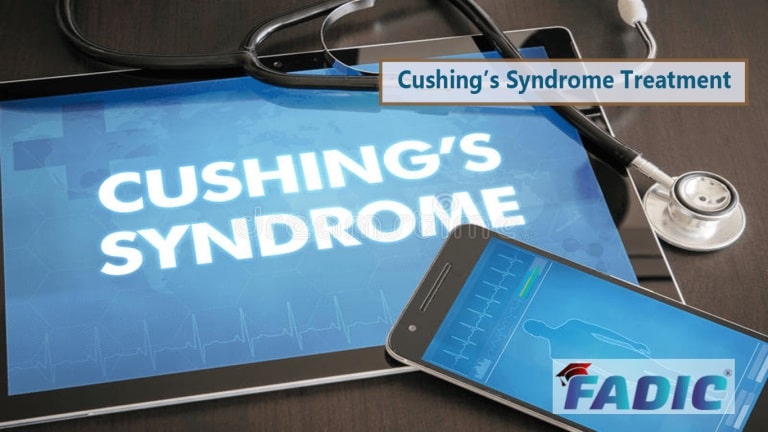Treatment of Cushing’s Syndrome

Treatment of Cushing’s Syndrome
- Cushing’s syndrome is usually due to a corticotropin (ACTH)-producing pituitary tumour (Cushing’s disease), ectopic ACTH secretion by a nonpituitary tumour, or cortisol secretion by an adrenal adenoma or carcinoma.
- There are also very rare tumors that secrete corticotropin-releasing hormone (CRH) ectopically, and occasional cases are caused by cortisol secretion by ACTH-independent macronodular or micronodular hyperplasia of the adrenal cortex.
How to treat Cushing’s Disease
- The approach to the treatment of Cushing’s disease as outlined here is consistent with the treatment of corticotropin (ACTH)-dependent Cushing’s syndrome.
1. Transsphenoidal surgery
- The treatment of choice for Cushing’s disease is transsphenoidal micro-adenomectomy when a clearly circumscribed microadenoma can be identified at surgery.
2. Medical therapy
- Although the hypercortisolism of Cushing’s disease is optimally treated surgically, medical therapy is often required when surgery is delayed, contraindicated, or unsuccessful.
- Adrenal enzyme inhibitors are the most commonly used drugs, but adrenolytic agents, drugs that target the pituitary, and glucocorticoid-receptor antagonists also have been used.
- Medical therapy targeting the corticotroph tumor such as cabergolineor pasireotidecan result in normalization of 24-hour urinary free cortisol in 20 to 40 percent of them, especially if they have only mild hypercortisolism.
- The glucocorticoid (as well as progestin) antagonist mifepristone is approved in the United States for treatment of glucose intolerance in patients with Cushing’s syndrome who are not surgical candidates. This topic is reviewed in detail separately
ECTOPIC ACTH AND CRH SYNDROMES
Ectopic ACTH
- The optimal therapy of the ectopic corticotropin (ACTH) syndrome (secretion of ACTH by a nonpituitary tumor) is surgical excision of the tumor, thereby removing the source of ACTH and curing the metabolic disorder.
Nonresectable tumors
- For those patients with nonresectable tumors, the hypercortisolism can be controlled with adrenal enzyme inhibitors, such as ketoconazole, metyrapone, and etomidate. Other potential treatment options that have been tried include mifepristone and octreotide.
- The glucocorticoid (as well as progestin) antagonist mifepristone has been used to control hyperglycemia secondary to hypercortisolism in adults with endogenous Cushing’s syndrome and type 2 diabetes or glucose intolerance who have failed surgery or are not candidates for surgery Octreotide, a long-acting analogue of somatostatin, rapidly reduces ectopic ACTH secretion by some nonpituitary tumors but does not usually reduce tumor size
Summary:
- The goal of treatment of all patients with Cushing’s syndrome is to achieve normalization of hypothalamic-pituitary-adrenal function and subsequent reversal of Cushingoid signs/symptoms and co-morbidities.
- Optimal treatment involves localization and complete removal of a corticotropin (ACTH)-secreting pituitary or ectopic tumor or cortisol-secreting adrenal tumor(s).
- In patients with Cushing’s disease who were not cured by pituitary surgery, medical therapy targeting the corticotroph tumor such as cabergoline orpasireotide can result in normalization of 24-hour urinary free cortisol in 20 to 40 percent of them, especially if they have only mild hypercortisolism.
- Pituitary irradiation is another second-line treatment for persistent or recurrent Cushing’s disease. Adrenal enzyme inhibitors must be used to control hypercortisolism until it is effective in approximately 85 percent of them. Bilateral adrenalectomy is a definitive treatment for ACTH-secreting pituitary or ectopic tumors.
- The physical symptoms and signs of Cushing’s syndrome resolve gradually over a period of two to 12 months after effective cure of Cushing syndrome. Hypertension, osteoporosis and glucose intolerance improve but may not disappear.
- Patients may have impaired quality of life for many years despite remission of hypercortisolism. However, the long-term prognosis of cured patients who had the benign disease is excellent. The prognosis of patients with malignancy is variable and relates to the ability to control hypercortisolism and treat cancer.
Read More:
- Antimicrobial Stewardship School
- Sepsis Training Program
- Download Pocket Guide for Antibiotic Pharmacotherapy Book
- Microbiology Course | ABC Bacteria
- Infectious Disease E-News | FREE Subscription
- ABC antimicrobials | Know all about the Antimicrobials
- Road Map to Antimicrobial Stewardship Training Program
- Register Now in FADIC Clinical Research School
- FADIC Drug Information Fellowship
- Buy FADIC Toolkit for Writing Research to Write a Great Research Paper
- Read 10 Skills You Must Learn to Make a Research via Google Scholar in Arabic
- The FADIC Online Continuous Medical Improvement Programs & Mini-Courses.
- Check Now FADIC Book store and Buy books in different specialties.
- Watch Now FADIC TV to Keep your self Updated.
- FADIC Podcast focusing on varieties of pharmacist perspectives in different specialties.
- Subscribe Now in FADIC 2020 Daily News (FNN) and Keep Updated.
- Check Now about Coronavirus Resource Information Center.

 Log in
Log in Sign up
Sign up